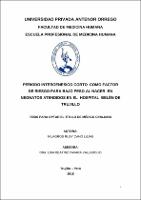| dc.contributor.advisor | Tavara Valladolid, Lida Beatriz | |
| dc.contributor.author | Cano Luján, Milagros Ruby | |
| dc.creator | Cano Luján, Milagros Ruby | |
| dc.date.accessioned | 2018-09-10T14:51:41Z | |
| dc.date.available | 2018-09-10T14:51:41Z | |
| dc.date.issued | 2018 | |
| dc.identifier.uri | https://hdl.handle.net/20.500.12759/4292 | |
| dc.description.abstract | OBJETIVO: Determinar si el periodo intergenésico corto es factor de riesgo
para el bajo peso al nacer.
MATERIAL Y MÉTODOS: Se realizó un estudio observacional, retrospectivo
de casos y controles. La muestra estuvo conformada por 345 historias clínicas
perinatales de madres con neonatos atendidos en el Área de Neonatología del
Hospital Belén de Trujillo entre 2015 – 2017 (Grupo casos - BPN=115, Grupo
control – sin BPN=230), además se analizó la influencia de variables
intervinientes como anemia y paridad.
RESULTADOS:
La edad promedio de las madres de neonatos con y sin bajo peso al nacer fue
28,41 ± (7,20) años y 26,84 ± (6,53) años respectivamente (p= 0,043). La edad
gestacional promedio entre los casos fue de 32,23 ± (4,17) semanas y en los
controles 39,02 ±(1,22) semanas. La mayoría de las madres provinieron de un
área urbana (67,8% vs 79,6%) y con grado de instrucción de secundaria
(48,7% vs 63%), presentando significancia estadística. La frecuencia del
periodo intergenésico corto en neonatos con bajo peso al nacer fue del 32% y
en neonatos sin bajo peso al nacer fue del 21 %. El análisis bivariado mostró
que el intervalo intergenésico corto presentó asociación estadísticamente
significativa, con un Odds Ratio 1,752 y valor de p=0.028 (Chi2= 4,840; IC
95%: 1,060 – 2,897). En el análisis multivariado, el periodo intergenésico corto
y la alta paridad presentaron significancia estadística (OR 1,829 [1,09 – 3,05],
p=0,021).
CONCLUSIONES: Las madres con periodo intergenésico corto tienen mayor
probabilidad de tener hijos con bajo peso al nacer; incluso si tienen alta
paridad. | es_PE |
| dc.description.abstract | OBJECTIVE: Determine if the short interpregnancy interval is a risk factor for
low birth weight.
METHODS: An observational, retrospective study of cases and controls was
carried out. The sample consisted of 345 perinatal clinical records of mothers
with neonates treated in the Neonatology Area of the Bethlehem Hospital of
Trujillo between 2015 - 2017 (Group cases - LBW = 115, Control group -
without LBW = 230), in addition the influence was analyzed of intervening
variables such as anemia and parity.
RESULTS: The average age of mothers of neonates with and without low birth
weight was 28.41 ± (7.20) years and 26.84 ± (6.53) years respectively (p =
0.043). The average gestational age among the cases was 32.23 ± (4.17)
weeks and in the controls 39.02 ± (1.22) weeks. The majority of the mothers
came from an urban area (67.8% vs 79.6%) and with high school education
(48.7% vs. 63%), presenting statistical significance. The frequency of the short
interpregnancy interval in neonates with low birth weight was 32% and in
neonates without low birth weight it was 21%. The bivariate analysis showed
that the short interpregnancy interval presented a statistically significant
association, with an Odds Ratio of 1,752 and a value of p = 0.028 (Chi2 =
4,840, 95% CI: 1,060 - 2,897). In the multivariate analysis, the short
interpregnancy interval and the high parity presented statistical significance (OR
1,829 [1,09 - 3,05], p = 0,021).
CONCLUSIONS: Mothers with a short interpregnancy interval are more likely to
have children with low birth weight; even if they have high parity. | en_US |
| dc.description.uri | Tesis | es_PE |
| dc.format | application/pdf | es_PE |
| dc.language.iso | spa | es_PE |
| dc.publisher | Universidad Privada Antenor Orrego | es_PE |
| dc.relation.ispartofseries | T_MED.HUMA_2424 | |
| dc.rights | info:eu-repo/semantics/openAccess | es_PE |
| dc.rights.uri | https://creativecommons.org/licenses/by/4.0/ | es_PE |
| dc.source | Universidad Privada Antenor Orrego | es_PE |
| dc.source | Repositorio Institucional - UPAO | es_PE |
| dc.subject | Bajo de peso al nacer | es_PE |
| dc.subject | Intervalo intergenésico | es_PE |
| dc.title | Periodo intergenesico corto como factor de riesgo para bajo peso al nacer en neonatos atendidos en el Hospital Belén de Trujillo | es_PE |
| dc.type | info:eu-repo/semantics/bachelorThesis | es_PE |
| thesis.degree.level | Título Profesional | es_PE |
| thesis.degree.grantor | Universidad Privada Antenor Orrego. Facultad de Medicina Humana | es_PE |
| thesis.degree.name | Médico Cirujano | es_PE |
| thesis.degree.discipline | Medicina Humana | es_PE |
| dc.subject.ocde | https://purl.org/pe-repo/ocde/ford#3.02.27 | es_PE |
| renati.type | https://purl.org/pe-repo/renati/type#tesis | es_PE |
| renati.level | https://purl.org/pe-repo/renati/level#tituloProfesional | es_PE |
| renati.discipline | 912016 | es_PE |
| dc.publisher.country | PE | es_PE |


